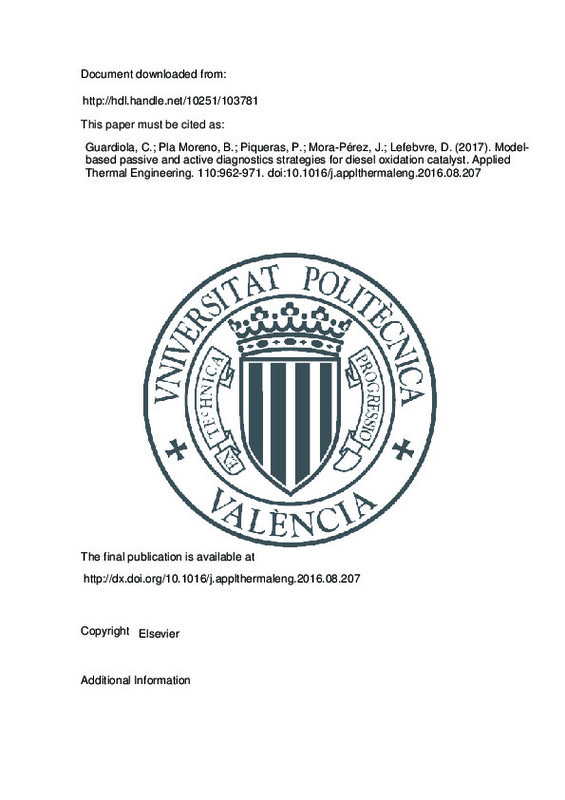JavaScript is disabled for your browser. Some features of this site may not work without it.
Buscar en RiuNet
Listar
Mi cuenta
Estadísticas
Ayuda RiuNet
Admin. UPV
Model-based passive and active diagnostics strategies for diesel oxidation catalyst
Mostrar el registro sencillo del ítem
Ficheros en el ítem
| dc.contributor.author | Guardiola, Carlos
|
es_ES |
| dc.contributor.author | Plá Moreno, Benjamín
|
es_ES |
| dc.contributor.author | Piqueras, P.
|
es_ES |
| dc.contributor.author | Mora-Pérez, Javier
|
es_ES |
| dc.contributor.author | Lefebvre, D.
|
es_ES |
| dc.date.accessioned | 2018-06-11T04:27:56Z | |
| dc.date.available | 2018-06-11T04:27:56Z | |
| dc.date.issued | 2017 | es_ES |
| dc.identifier.issn | 1359-4311 | es_ES |
| dc.identifier.uri | http://hdl.handle.net/10251/103781 | |
| dc.description.abstract | [EN] This article proposes a diesel oxidation catalyst diagnostics strategy based on the exothermic process generated by exhaust gas species oxidation in the catalyst. The diagnostics strategy is designed to be applied on-board and respecting real-time electronic control unit computational limitations. Diagnostics purposes are fulfilled by means of the comparison of the passive model temperature, which represents the outlet temperature of a non-impregnated diesel oxidation catalyst, and the measurement provided by the on-board catalyst-out temperature sensor. Thus, the presented diagnostics strategy uses only two production grade temperature sensors and the measurements of air and fuel mass flows from the electronic control unit. Passive diagnostics is based on the oxidation of engine-raw emissions, whilst active diagnostics is based on the oxidation of requested post injected fuel. Post-injection strategy is also discussed for active diagnosis. Then, the diagnostics strategy is able to discern whether the diesel oxidation catalyst is able to oxidise or not. (C) 2016 Elsevier Ltd. All rights reserved. | es_ES |
| dc.description.sponsorship | This research has been partially financed by the Spanish Ministerio de Economia y Competitividad, through project TRA2013-40853-R 'Desarrollo de nuevas tecnicas de limitacion de la perdida de presion en DPFs para reducir las emisiones y el consumo de los motores diesel (PRELIMIT)'. | |
| dc.language | Inglés | es_ES |
| dc.publisher | Elsevier | es_ES |
| dc.relation.ispartof | Applied Thermal Engineering | es_ES |
| dc.rights | Reconocimiento - No comercial - Sin obra derivada (by-nc-nd) | es_ES |
| dc.subject | Diesel oxidation catalyst | es_ES |
| dc.subject | Thermal model | es_ES |
| dc.subject | Diagnosis | es_ES |
| dc.subject | Post-injection | es_ES |
| dc.subject | Turbocharged engine | es_ES |
| dc.subject.classification | INGENIERIA AEROESPACIAL | es_ES |
| dc.subject.classification | MAQUINAS Y MOTORES TERMICOS | es_ES |
| dc.title | Model-based passive and active diagnostics strategies for diesel oxidation catalyst | es_ES |
| dc.type | Artículo | es_ES |
| dc.identifier.doi | 10.1016/j.applthermaleng.2016.08.207 | es_ES |
| dc.relation.projectID | info:eu-repo/grantAgreement/MINECO//TRA2013-40853-R/ES/DESARROLLO DE NUEVAS TECNICAS DE LIMITACION DE LA PERDIDA DE PRESION EN DPFS PARA REDUCIR LAS EMISIONES Y EL CONSUMO DE LOS MOTORES DIESEL/ | es_ES |
| dc.rights.accessRights | Abierto | es_ES |
| dc.date.embargoEndDate | 2019-01-05 | es_ES |
| dc.contributor.affiliation | Universitat Politècnica de València. Departamento de Máquinas y Motores Térmicos - Departament de Màquines i Motors Tèrmics | es_ES |
| dc.description.bibliographicCitation | Guardiola, C.; Plá Moreno, B.; Piqueras, P.; Mora-Pérez, J.; Lefebvre, D. (2017). Model-based passive and active diagnostics strategies for diesel oxidation catalyst. Applied Thermal Engineering. 110:962-971. https://doi.org/10.1016/j.applthermaleng.2016.08.207 | es_ES |
| dc.description.accrualMethod | S | es_ES |
| dc.relation.publisherversion | http://dx.doi.org/10.1016/j.applthermaleng.2016.08.207 | es_ES |
| dc.description.upvformatpinicio | 962 | es_ES |
| dc.description.upvformatpfin | 971 | es_ES |
| dc.type.version | info:eu-repo/semantics/publishedVersion | es_ES |
| dc.description.volume | 110 | es_ES |
| dc.relation.pasarela | S\323251 | es_ES |
| dc.contributor.funder | Ministerio de Economía, Industria y Competitividad | es_ES |







![[Cerrado]](/themes/UPV/images/candado.png)

